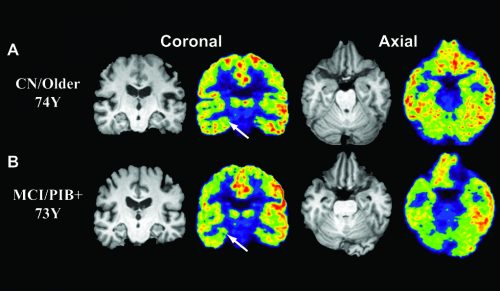Alzheimer’s disease (AD), which currently affects more that 5.7 million people in the US, is a neurodegenerative disease that greatly impairs memory. Despite the vast field of research dedicated toward tackling Alzheimer’s, there is still no cure. Erik Gunther, along with a team of Yale researchers in Professor Stephen Strittmatter’s lab, has discovered a promising drug to reverse the progression of AD. After screening over 60,000 compounds at the Yale Small Molecule Discovery Center, they developed a new compound that, instead of simply treating AD symptoms like currently approved drugs, can reverse neural connection loss and memory defects in mice.
To better unravel the mechanism of the drug, it is important to understand AD development. AD results from an accumulation of β-amyloid peptides, which are small proteins present only in low concentrations in non-Alzheimer’s patients. In AD patients, β-amyloid peptides clump together to form β-amyloid oligomers, which then further combine to form β-amyloid plaques that look like “rocks in the brain,” according to Strittmatter. β-amyloid oligomers are problematic because they interact with neurons to set off a cascade of molecular events that damages synapses–the connections between neurons–and thus lead to memory impairment. Ten years ago, Strittmatter demonstrated that β-amyloid peptide binds strongly to cellular prion protein (PrP), a protein on the surface of neurons, so he began to investigate how to block this damaging interaction from occurring.
Strittmatter’s lab initially screened over 12,000 compounds, hoping to find one that would inhibit the β-amyloid oligomer interaction with PrP. They first identified the antibiotic cefixime as a potential candidate, which, unusually, was only effective after it had degraded–since most drugs are effective before they start to degrade. If cefixime had not degraded by the time the research team screened it, Strittmatter believes, “We might still be searching [for a compound].”
Other antibiotics with analogous structures to cefixime’s yielded similar results. After further testing, the team switched their focus toward the degraded product of the antibiotic ceftazidime because it was more effective than the degraded product of cefixime. Through further analysis, the research team learned that ceftazidime decomposes and reacts with itself to create a different polymer, referred to as Compound Z, that inhibits β-amyloid oligomer interaction with PrP.
Although the researchers knew Compound Z has inhibitory activity, they were uncertain whether it binds to PrP. Using antibodies constructed to bind to specific regions of PrP, they found that Compound Z binds to two regions of PrP that interact with the β-amyloid oligomer, preventing any interaction between β-amyloid oligomers and PrP.
Once the researchers elucidated this pathway, they tested Compound Z’s effect on neurons. Even in a petri dish, neurons exposed to β-amyloid oligomers have damaged synapses, but Strittmatter’s lab found that Compound Z reduces β-amyloid oligomer binding to neurons by over eighty percent and reduces the loss of dendritic spines–an essential component of neuron signaling–by eight-fold. With these promising results, they administered Compound Z to mice engineered with Alzheimer’s-like disease. The researchers knew they had discovered a potential treatment for AD when the mice recovered learning and memory function.
This compound, however, was unable to bypass the brain’s filtration system, the blood-brain barrier, rendering it difficult to use as a potential therapeutic. Strittmatter’s lab needed to find a compound that could cross the blood-brain barrier. They tested over 56,000 molecules until they landed on a synthetic compound poly(4-styrenesulfonnic acid-co-maleic acid), abbreviated as PSCMA. Similar to Compound Z, PSCMA has inhibitory properties, but unlike Compound Z it can be administered orally and thus is considerably more practical as a potential drug.
Though the mice in this study were able to complete memory tasks with the remaining β-amyloid oligomers in the brain, the results will not necessarily translate in human subjects. “[The mice models] are not a complete picture of human AD.” Strittmatter acknowledged.
There are numerous steps before human trials can begin, but the researchers’ main goal now is to find the ideal balance between maintaining the drug’s inhibitory activity while optimizing the drug’s access to the brain. Strittmatter hopes to eventually test whether a drug from his lab might prove effective in treating AD in humans. “My optimism is high because I really believe we have a molecular basis for its effectiveness, and while these animal models are not perfect, they are the best predictors we have at this time,” he said.

